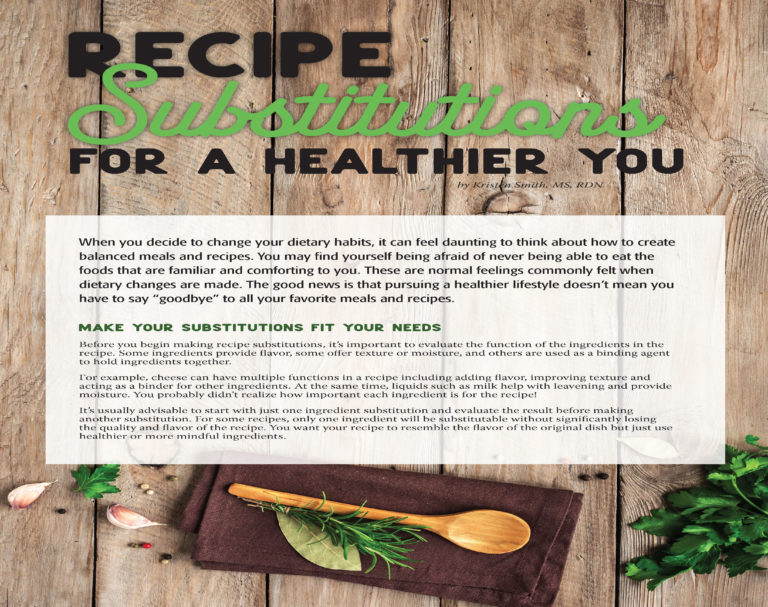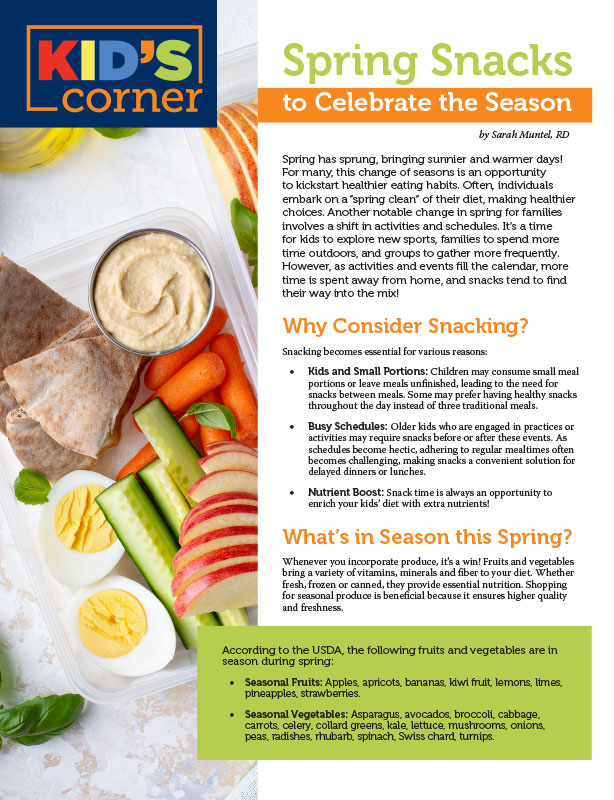Recipe Substitutions for a Healthier You


by Kristen Smith, MS, RDN
Winter 2022
When you decide to change your dietary habits, it can feel daunting to think about how to create balanced meals and recipes. You may find yourself being afraid of never being able to eat the foods that are familiar and comforting to you. These are normal feelings commonly felt when dietary changes are made. The good news is that pursuing a healthier lifestyle doesn’t mean you have to say “goodbye” to all your favorite meals and recipes.
Make Your Substitutions Fit Your Needs
Before you begin making recipe substitutions, it’s important to evaluate the function of the ingredients in the recipe. Some ingredients provide flavor, some offer texture or moisture, and others are used as a binding agent to hold ingredients together.
For example, cheese can have multiple functions in a recipe including adding flavor, improving texture and acting as a binder for other ingredients. At the same time, liquids such as milk help with leavening and provide moisture. You probably didn’t realize how important each ingredient is for the recipe!
It’s usually advisable to start with just one ingredient substitution and evaluate the result before making another substitution. For some recipes, only one ingredient will be substitutable without significantly losing the quality and flavor of the recipe. You want your recipe to resemble the flavor of the original dish but just use healthier or more mindful ingredients.
Let’s walk through the different functions of recipe ingredients and discuss possible substitutions.
Flavor
Most ingredients have multiple functions; however, typically more than one ingredient will function as a flavoring agent for the recipe. When you are trying to modify recipes for a healthier result, the ingredients that affect the flavor but minimize health benefits are those higher in fat or sugar. Numerous recipes include fats such as butter, oil or shortening to help balance and blend the flavors of certain ingredients or enhance the overall flavor of the recipe. Sweeteners such as sugar and honey are used in recipes to help balance sour or bitter flavors.
Here are some recipe hacks to decrease the fat and sugar used to flavor recipes:
- For marinades and sauces, reduce the sugar amount by 1/3 to ½ of what’s called for in the recipe.
- Use sugar-free syrups to replace regular syrups.
- Use canned fruit in water or natural juice rather than in syrup.
- Increase other spices in the recipe when you decrease the amount of sugar .
- Substitute 1/3 to ½ of sugar in a recipe with a fig or prune puree (works in both savory recipes and baked goods).
- When sautéing vegetables, replace half of the oil with a broth such as vegetable or chicken.
- Replace oil in baked goods with applesauce, pureed dates or mashed bananas. Start by replacing half of the oil with an equal amount of fruit puree.
- Create your own salad dressings with less oil by blending together vinegar, spices and a splash of fresh fruit juice.
- In savory dishes or baked goods, replace sour cream or cream cheese with plain Greek yogurt.
- Instead of using cream to thicken soups, use one-half cup of pureed cannellini beans blended with one cup of soup broth.
Greek Yogurt Twice Baked Potatoes
Ingredients:
- 4 medium potatoes, rinsed
- 2/3 cup plain Greek yogurt
- 2/3 cuplow-fat cheddar cheese, shredded
- 2/3 cuplow-fat milk
- 2 tbsp.butter
- ½ tsp. salt
- ½ tsp. pepper
- Optional: Green onions, turkey bacon, additional salt
Instructions:
- Preheat oven to 350º Fahrenheit.
- Place potatoes on a baking sheet and spread them out a few inches apart.
- Bake the potatoes at 350º for about one hour or until soft to touch.
- Let the potatoes cool for about 10-15 minutes; slice potatoes in half lengthwise and scoop the insides into a large bowl.
- In a large bowl, add the Greek yogurt, half of your cheese mixture, milk, butter, salt and pepper.
- Using a mixer, blend until well combined.
- Spoon the mixture into the potato skins and top with the remaining cheese.
- Bake at 350º for another 12-17 minutes or until cheese is slightly browned.
Texture
The texture of foods can be affected by ingredients that add moisture or the types and amounts of starchy ingredients. Higher-fat dairy products or cooking oils are often added to recipes to keep them moist and creamy. Starchy ingredients such as pasta or breadcrumbs can add a chewy or crunchy texture. When making substitutions to create a healthier recipe, it can be difficult to maintain the recipe’s original texture. Here are some tips for swapping out ingredients without significantly steering away from the original texture of the recipe.
-
- Replace high-fat dairy products like milk and cheese with lower-fat options (non-fat dairy products usually don’t work out).
- Use whole grain or vegetable-based pasta for regular white pasta.
- Substitute white rice with riced cauliflower, brown rice or quinoa.
- Swap cream cheese in recipes with plain full-fat Greek yogurt.
- In baked goods, substitute half to all of the all-purpose flour with 100% whole wheat flour.
- Replace croutons in salads and soups with crunchy nuts and seeds.
Binding Agents
Binding agents are any ingredient that can help a recipe hold its shape or remain bound together. In some instances, binding agents may also add texture to the recipe. Egg, flour and cheese are some of the most popular binding agents, but other food binders include breadcrumbs, rice, milk and oatmeal.
Below are several tricks to substitute some of the higher-calorie and less nutrient-dense ingredients used as binding agents in recipes:
-
-
- Replace store-bought breadcrumbs with crushed bran flakes or oats that have been pulsed in a food processor.
- When baking, skip the eggs and replace with a flaxseed “egg” made by mixing one tablespoon of ground flaxseed with three tablespoons of water.
- Substitute whole milk cheese with reduced-fat versions.
-
Conclusion
Making healthier substitutions can be easy and leave your dish tasting just as delicious! Cooking with healthier ingredients doesn’t have to completely change the taste of the dish, and most of the time, you won’t even notice anything is different!
About the Author:
Kristen Smith, MS, RDN, is a bariatric surgery program coordinator in Atlanta, Georgia. Kristen has been a practicing registered dietitian for nearly two decades and is a national spokesperson for the Academy of Nutrition and Dietetics. Her nutrition expertise has been featured in interviews on Good Morning America, The New York Times, WebMD, US News and much more!
by Sarah Muntel, RD Spring 2024 Spring has sprung, bringing sunnier and warmer days! For many, this…
Read ArticleWith the holidays behind us and 2022 now here, many of us are ready to tackle our…
View Videoby Amy Thul, RD, LD, CSOWM Winter 2022 It’s dinner time and you’re running around the kitchen,…
Read Article









